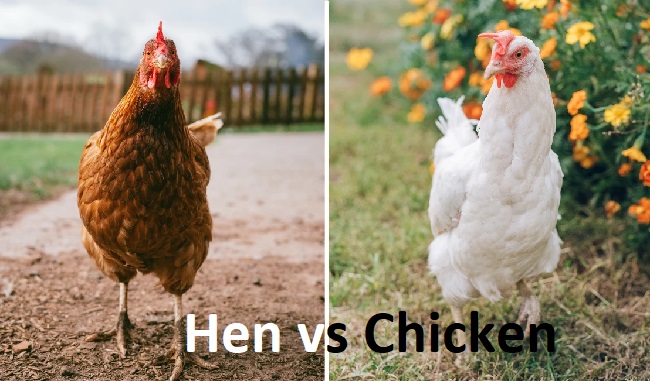There’s a common question that pops up amongst poultry enthusiasts and curious minds alike – “What’s the difference between a hen and a chicken?”
Despite the terms often being used interchangeably, there are key distinctions to be aware of. In this detailed guide, we’ll unravel the subtle, yet significant differences between hens and chickens.

What is a Chicken?
A chicken is a domesticated fowl, scientifically known as Gallus gallus domesticus. The term “chicken” is a broad one, encompassing the entire species, including both males and females, and birds of all ages.
Read Also:
So, when you talk about chickens, you’re referring to the entire population of this domesticated bird species.
What is a Hen?
A hen, on the other hand, is a term specifically used to denote adult female chickens. Once a female chicken reaches the age of laying eggs, typically around five months old, she is referred to as a hen. Hens play a critical role in poultry farming, being the primary source of eggs for consumption and hatching.
Key Differences between Hen and Chicken
Here is the key difference between hen and chicken:
Gender and Age
The most significant difference lies in gender and age. While ‘chicken’ is a gender-neutral term, ‘hen’ refers specifically to adult female chickens.
Role in Poultry Farming
Their roles within poultry farming also differ. Hens are valued for their ability to lay eggs, while chickens, in the broader sense, may be raised for different purposes, such as for meat (broilers) or for their egg-laying capabilities (layers).
Other Terms in Poultry: Roosters, Pullets, and Cockerels
Understanding the terms ‘hen’ and ‘chicken’ also benefits from knowing other relevant poultry terms:
Rooster: An adult male chicken, known for its vibrant plumage and crowing.
Pullet: A young female chicken that hasn’t started laying eggs yet.
Cockerel: A young male chicken less than a year old.
Breeding and Behaviour: Hens vs. Chickens
When it comes to breeding and behavior, hens and chickens (or roosters, to be more precise) have distinct roles.
Roosters: The Protectors
Roosters are often characterized as the protectors of the flock. They are alert and vigilant, keeping an eye out for any potential threats to their hens. These threats can range from predatory birds to humans.
In addition, roosters crow loudly, which is often used as a territorial call to signal their dominance to other roosters.
Hens: The Nurturers
Hens have a strong nurturing instinct. Once they start laying eggs, they will look for a quiet and secluded place to make a nest.
If a hen decides to hatch her eggs, she will go into a state called “broodiness.” During this period, a hen will sit on her eggs for about 21 days, only leaving her nest briefly to eat and drink.
Egg-Laying Process
One of the most fascinating aspects of a hen’s life is the egg-laying process. On average, a healthy hen will lay an egg every 24 to 27 hours. The process starts with the yolk being released into the hen’s oviduct.
The yolk then travels down the oviduct, where it gets covered in albumen (egg white), membranes, and lastly, the shell. Once the egg is fully formed, the hen will lay it and the process begins anew.
Understanding Chickens’ Social Structure: The Pecking Order
Chickens are social creatures with a hierarchical structure known as the “pecking order.” This structure helps to maintain order and reduce conflict within the flock.
The pecking order is established early on and often dictates everything from who eats first to who gets the best nesting spots.
Read Also:
Conclusion
The difference between hens and chickens boils down to age and gender. All hens are chickens, but not all chickens are hens. This distinction is fundamental in poultry farming and understanding the life cycle and dynamics of this fascinating species.
Remember, the term ‘chicken’ encompasses the entire species, while ‘hen’ refers to adult female chickens. It’s just one of the many fascinating aspects of poultry farming and bird species. Stay curious, keep learning, and enjoy the fascinating world of chickens and hens!
























